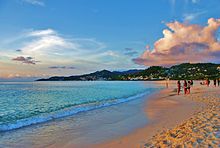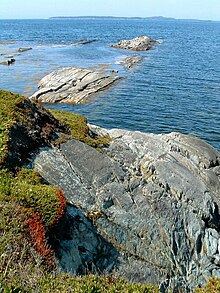Shore





A shore or a shoreline is the fringe of land at the edge of a large body of water, such as an ocean, sea, or lake. In physical oceanography, a shore is the wider fringe that is geologically modified by the action of the body of water past and present, while the beach is at the edge of the shore, representing the intertidal zone where there is one.[1] In contrast to a coast, a shore can border any body of water, while the coast must border an ocean. Therefore, in that sense, a coast is a type of shore. However, the word "coast" often refers to an area far wider than the shore, often stretching miles into the interior.
Shores are influenced by the topography of the surrounding landscape, as well as by water induced erosion, such as waves. The geological composition of rock and soil dictates the type of shore which is created.
Rivieras
Riviera is an Italian word for "shoreline",[2][3][4] ultimately derived from Latin ripa ("riverbank"). It came to be applied as a proper name to the coast of the Ligurian Sea, in the form riviera ligure, then shortened to riviera. Historically, the Ligurian Riviera extended from Capo Corvo (Punta Bianca) south of Genoa, north and west into what is now French territory past Monaco and sometimes as far as Marseilles.[2][5][6] Today, this coast is divided into the Italian Riviera and the French Riviera, although the French use the term "Riviera" to refer to the Italian Riviera and call the French portion the "Côte d'Azur".[3]
As a result of the fame of the Ligurian rivieras, the term came into English to refer to any shoreline, especially one that is sunny, topographically diverse and popular with tourists.[2] Such places using the term include the Australian Riviera in Queensland and the Turkish Riviera along the Aegean Sea.[3]
See also
- Offshore or Intertidal zone
- Ballantine Scale
- Coastal path
- Shorezone
References
- ^ Pickard, George L.; William J. Emery (1990). Descriptive Physical Oceanography (5, illustrated ed.). Elsevier. pp. 7–8. ISBN 075062759X.
- ^ a b c "riviera". Chambers Concise Dictionary. New Delhi: Allied Chambers. 2004. p. 1045. ISBN 9788186062364.
- ^ a b c Kolb, Martina (2013). Nietzsche, Freud, Benn, and the Azure Spell of Liguria. Toronto, Ontario: University of Toronto Press. p. 30. ISBN 978-1-4426-4329-1.
- ^ The more common ones are puntellare and litorale.
- ^ Baughan, Rosa (1880). Winter havens in the sunny South, a complete handbook to the Riviera. London: The Bazaar. Archived from the original on 2017-02-02.
- ^ Black, Charles B. (1887). The Riviera, Or The Coast from Marseilles to Leghorn, Including Carrara, Lucca, Pisa, Pistoja and Florence (Third ed.). Edinburgh: Adam and Charles Black. Archived from the original on 2017-02-02.
Further reading
- Anders, F.J., and Byrnes, M.R. (1991) Accuracy of shoreline change rates as determined from maps and aerial photographs Shore and Beach, v. 59, no. 1, pp. 17–26.
- Anthony, Edward J. (2008) Shore Processes and their Palaeoenvironmental Applications Elsevier, Amsterdam, ISBN 978-0-08-055886-8
- Boaden, Patrick J. S. and Seed, Raymond (1985) An Introduction to Coastal Ecology Blackie, Glasgow, ISBN 978-0-412-01021-7
- Bothner, M.H., and Butman, Bradford. (2007) Processes influencing the transport and fate of contaminated sediments in the coastal ocean—Boston Harbor and Massachusetts Bay, U.S. Geological Survey Circular 1302, pp. 1–89.
- Dean, R.G. (1991) Equilibrium beach profiles—characteristics and applications Journal of Coastal Research, v. 7, no. 1, pp. 53–84.
- Komar, P.D. (1996) The Budget of Littoral Sediments—Concepts and Applications Shore and Beach, v. 64, pp. 18–26.
- Meade, Robert H. (1982). "Sources, Sinks, and Storage of River Sediment in the Atlantic Drainage of the United States". The Journal of Geology. 90 (3): 235–252. Bibcode:1982JG.....90..235M. doi:10.1086/628677. S2CID 96470785.
- Stauble, D.K. and Brumbaugh, R.W. (2003) An Assessment of the Nation's Shorelines, USA Shore and Beach v. 71, no. 3, pp. 11–18.
- Stockdon, H.F., Sallenger, A.H., List, J.H., and Holman, R.A. (2002) Estimation of shoreline position and change using airborne topographic lidar data Journal of Coastal Research, v. 18, no. 3, pp. 502–513.
- Thieler, E.R., Pilkey, O.H., Young, R.S., Bush, D.M., and Chai, F. (2000) The use of mathematical models to predict beach behavior for U.S. coastal engineering—A critical review Journal of Coastal Research, v. 16, no. 1, pp. 48–70.
External links
 Media related to Shores at Wikimedia Commons
Media related to Shores at Wikimedia Commons- "shore". The American Heritage Dictionary of the English Language (4 ed.). 2000. Archived from the original on 2009-05-08.
- "shore". Merriam-Webster Online. 2009.

